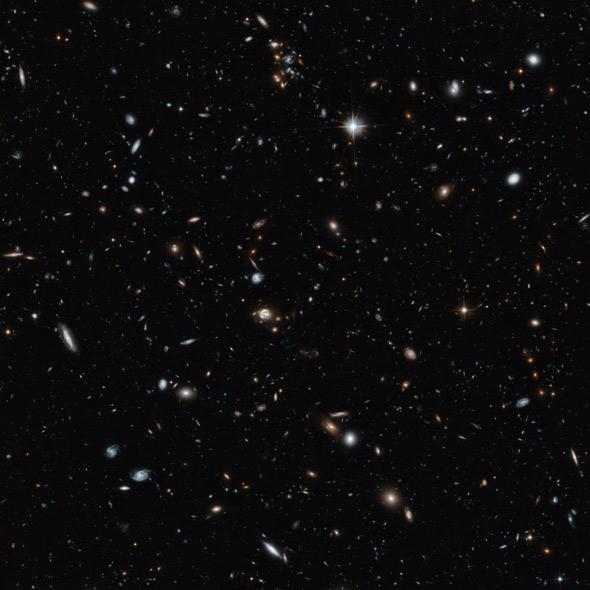What happens when you take a 2.4-meter telescope, launch it into space, and command it to stare at one spot in the sky for a solid 14 hours, taking data both in visible light (like our eyes see) and infrared?
This. This.

All photos by NASA/ ESA
Can I get a “Yowza!” from the congregation? No? Maybe that’s because when I shrink this Hubble Space Telescope picture down to fit the blog you can’t really get a sense of what you’re seeing here. So click the picture to get the 1280 x 1280 image, or better yet, do yourself and your eyeballs a favor and take a poke at the huge 3900 x 3900 pixel version, because holy wow.
What you’re seeing here is a view of thousands of galaxies. Thousands. Sure, there are some stars in our own Milky Way punctuating this picture here and there but they are few, and just stomped flat by the number of whole galaxies you’re seeing. The stars can be distinguished from galaxies because they’re point sources; small dots. They also might have those lines going through them called diffraction spikes. Galaxies don’t usually get those because they’re fuzzier, spread out over many pixels. That suppresses the diffraction spikes.
So for example that bright point with pretty spikes you see toward the upper right is a star, probably a few thousand light years from Earth. That’s a long way to be sure, but even the nearest galaxies you can see in this image are hundreds of millions of light years away! Some are billions; the most distant objects in this shot are at least 9 billion light years distant. That’s a million times farther away than any star in the picture.
When the light we see here left those galaxies, the Sun hadn’t yet formed. When the Earth itself was coalescing from countless specks of dust, that light still had half its journey here ahead of it.
So yeah. This stuff is far.
In fact you’re seeing galaxies at all different distances from Earth in this image, but the observation itself was taken to look at the cluster of galaxies in the center. Called CLASS B1608+656, it’s a clump of galaxies about five billion light years away. The mass of that cluster acts like a lens, bending space, magnifying objects behind it. This gravitational lens has distorted and amped up the brightness of a luminous galaxy located an additional several billion light years behind it, creating the weirdly shaped mess you see in the close-up above. Rings and arcs are common in such events.
But there’s so much more to this image; just scanning across it reveals an incredible variety and diversity of galaxies. Remember, too, you’re looking at objects as they existed eons ago; many are still growing, suffering collisions with other galaxies, giving them fantastic shapes. As an example, I’m fond of this little group near the top of the main image:
I’m not precisely sure what to make of this. The bigger galaxies look to all be about the same distance from us, but that could be a coincidental alignment. Some of the galaxies are blue and clumpy looking, indicating they’re aggressively forming stars (hot, young, massive stars are preferentially blue), while some are quite red. The red ones may be very dusty, which reddens the light from stars, or they may be farther away, their light redshifted as it fights against the expansion of the Universe itself, losing energy along the way. It may be a mix of both. Unfortunately, this image was made using only two filters, so colors can be difficult to interpret, and don’t yield a lot of subtle information. The only way to know more about the galaxies would be to measure their distance, and I didn’t find anything in the literature about them.
That’s worth taking a moment to ponder, actually. These are entire galaxies, collections of tens of billions of stars, planets, dust, and gas clouds, each and every one a monstrous object on scales that dwarf our everyday experience … yet there are so many of each of them in this image alone we can’t possibly know their details. We can determine their coordinates on the sky, get a rough estimate of their distance, but there is simply no way to get a measure of them as individuals. They are too many. It’s like trying to get the life history of everyone who passes you on a busy New York City street corner. The task is too overwhelming.
And just in case I have not yet crushed your puny human mind, this image represents a tiny fraction of the entire sky; perhaps only one ten-millionth of it. That means there are hundreds of billions of galaxies like these scattered throughout the Universe.
So gaze again at that image, one that drills a narrow but incredibly deep view through our cosmos, one that shows us both the awe-inducing grandeur and soul-squeezing immensity of it, and remember: The Universe is far, far larger than this still.
And yet here we are, pondering it. To those galaxies, we are the ones who are lost in the anonymous throng. Yet I would argue we are as important and interesting a piece of the Universe as any other we can imagine. We are part of it at the same time as we study it, and to me, that is part of what makes us great.